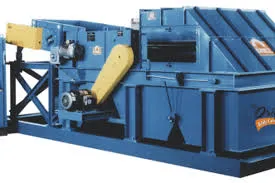

நவ் . 16, 2024 21:34 Back to list
The Evolution and Impact of Scrap Yard Shredders
In today’s rapidly changing world, the need for sustainable waste management solutions has never been more pressing. Among the many innovative technologies that have emerged to address this need, scrap yard shredders play a pivotal role. These powerful machines are not only crucial for recycling and waste management but also for resource recovery in various industries.
Understanding Scrap Yard Shredders
A scrap yard shredder is a specialized machine designed to break down large scrap materials into smaller, manageable pieces. This process, known as shredding, is fundamental in the recycling industry, particularly for metals, plastics, and various electronic waste. The shredders come in various configurations, catering to different types of materials and operational scales. Whether it’s a portable shredder for smaller operations or a larger, stationary unit for industrial applications, these machines are engineered for efficiency and durability.
The Mechanism Behind Shredding
Scrap yard shredders operate using a series of rotating blades or hammers that shred, tear, and crush materials into smaller sizes. The specific design of these blades can vary depending on the intended material being processed. For instance, metal shredders feature heavy-duty blades made from hardened steel to withstand the rigors of cutting through tough materials, while plastic shredders may employ different blade configurations to optimize the process.
The process typically involves feeding raw materials into the shredder, where they are subjected to high forces that break them down. The shredded material can then be further processed, sorted, and recycled into new products, significantly reducing the volume of waste sent to landfills.
Applications and Benefits
The applications of scrap yard shredders are vast and diverse. In the automotive industry, for example, end-of-life vehicles are often shredded to recover valuable metals such as steel and aluminum. This recycling process not only reintroduces these materials into the supply chain but also reduces the environmental impact of mining and processing new ores.

In construction and demolition, shredders help break down debris materials like concrete, wood, and metals, enabling recycling and reducing landfill use. Similarly, in the electronics industry, e-waste shredders are essential for extracting valuable components from discarded devices while ensuring proper disposal of hazardous materials.
Beyond resource recovery, the benefits of scrap yard shredders extend to economic, environmental, and social aspects. They help create jobs in the recycling sector, promote the circular economy by turning waste into valuable resources, and reduce the carbon footprint associated with waste management.
Environmental Impacts
The environmental benefits of using scrap yard shredders are significant. By facilitating the recycling of materials, shredders substantially reduce the energy and resources required to produce new products. Additionally, shredding helps minimize the amount of waste that ends up in landfills, contributing to a cleaner and more sustainable environment.
Furthermore, the shredding process can mitigate pollution. For instance, removing hazardous e-waste components prevents toxic substances from leaching into the ground and water systems. Properly configured shredders can also minimize emissions during the shredding process, adhering to environmental regulations and standards.
The Future of Scrap Yard Shredders
As industries and societies continue to pivot towards sustainability, the importance of advanced scrap yard shredding technologies will only grow. Innovations such as automation, artificial intelligence, and improved materials are enhancing the efficiency and effectiveness of these machines.
Future shredders may incorporate smart technologies that allow for better monitoring and optimization of the shredding process, resulting in lower energy consumption and waste generation. Additionally, the development of more versatile shredding machines will enable a broader range of materials to be processed.
In conclusion, scrap yard shredders are not just machines; they are vital components of a sustainable waste management infrastructure. By facilitating the recycling of valuable materials, they contribute to environmental protection, economic growth, and resource conservation. As technology continues to evolve, so too will the impact and efficacy of scrap yard shredders, making them indispensable in the quest for a greener future.
Latest news
Troubleshooting Common Eddy Separator Problems
NewsJul.04,2025
The Role of Metal Recycling Plants in Circular Economy
NewsJul.04,2025
The Impact of Recycling Line Pickers on Waste Management Costs
NewsJul.04,2025
Safety Features Every Metal Shredder Should Have
NewsJul.04,2025
How Industrial Shredders Improve Waste Management Systems
NewsJul.04,2025
How Cable Granulators Contribute to Sustainable Recycling
NewsJul.04,2025